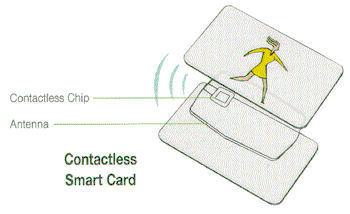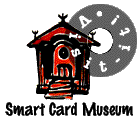|
Smart Cards
DEFINITION
by Katie Krakowiak
|

|
SMART CARD is nothing more than a plastic, credit-card size card with
one or more embedded computer chip. It looks and feels just like an oridinary
credit card. However, it is the chip inside, which by allowing functionality to be
added to the card, makes it SMART. This chip could be either a:
- microprocessor with internal memory allowing the card to make calculations,
process data, manage files and execute encryption algorightms
- memory chip with non-programmable logic allowing the card to only store
information and to reuse the card's memory by rewriting over its existing data
- combination which along with the integrated circuits can include technologies such
as magnetic stripe, optical memory and barcode for greater data storage
Therefore, a plastic card that fits on a human palm, can be nearly as powerful as the desktop
computer years ago. It has the ability to process data off-line, handle encrypted security,
can be reprogrammed and reused and it allows multiple applications be integrated in it.
The above are also some of the advantages of a smart card over a traditional magnetic stripe
card. Smart cards allow thousands of times the information storable on magnetic stripe cards.
In addition, smart cards are more reliable, perform multiple functions and are more secure
because of high security mechanisms such as advanced encryption and biometrics. In general,
the following are the main differences between these two types of cards:
|
Smart Card
|
Magnetic Stripe Card
|
- Greater storage capacity
- Enhanced data security with Encryption,
Biometrics, and/or PIN
- Multiple applications on one card
- Convenience
- Efficient off-line and on-line processing
- Easier record keeping
- Less paperwork
|
- Limited amount of data storage
- Data cannot be changed or duplicated easily
- Subject to wear and tear
- Magnetic strip can lose its magnetism with
continued swipes
- Designed for simple, repetitive tasks
- Read-only data
|
Source: http://www.advancedcard.com/future.html
Microprocessor cards, in particular, are used for a variety applications, especially those
that have crypthography built in them, which requires manipulation of large numbers. Thus,
chip cards have been the main platform for cards that hold a secure digital identity.
For example,
- cards that hold money or money equivalents
- cards that provide secure access to network
- cards that secure cellular phones from fraud
- cards that allow set-top boxes on televisions to remain secure from piracy
Memory cards, on the other hand, only store data (up to 1-4 KB) and cannot manipulate it
themselves. They are dependend on a card reader for processing and are suitable for uses
where the card performs a fixed operation. They are most popular so far and represent
high-security alternatives to magnetic stripe cards.
Optical memory cards look like they havce a piece of CD glued on top of them.
They can store up to 4 MB of data, but their memory is not reusable. Therefore, they
are ideal for record keeping, such as medical files, driving records, or travel histories.
Optical memory cards have no processor in them yet, their card readers use non-standard
protocols and are very expensive.
All these different types of smart cards fall into two general categories: contact and
contactless.

|
Contact cards require insertion into a smart card reader. They
have metalic surface, which must physically touch the
corresponding contacts in a reader. The transmission of
commands, data and card status takes place via these
physical contact points.
|
|

|
Contactless cards do not require physical contact with the
reader in order to transfer data. Data exchange is done by
electromagnetic coupling or radion frequency. Usually, both
the reader and the card have antena through which they
communicate. Most cards also derive their internal chip
power source from this electromagnetic signal. The range
is typically 2-3 inches for non-battery powered cards.
|
|
|
Source: http://www.scia.org/aboutSmartCards/overview.html
Two additional categories lately derived from the contact and contactless cards:
combi and hybrid. A hybrid card has two chips, each with its respective contact and
contactless interface. These chips are not connected, but serve the consumers' needs.
Combi cards have a single chip and a contact and contactless interface. They now
enable access to the same chip via a contact or contactless interface, with a very
high level of security. The mass transportation and banking industries are expected
to be the first to take advantage of this technology.
The physical structure of a smart card is specified by the (
International Standards
Organization (ISO) 7810, 7816/1 and 7816/2. These
standards are derived from the financial ID card standards and, besides the physical
structure, they also detail the electrical, mechanical and application programming
interface to a contact chip card.
To see how smart cards have evolved
over the past several years, visit the
Smart Card Museum:
|

|
All types of smart cards are today utilized by almost every economic sector in the world.
Here is a short summary of smart card application usage with the following statistical growth
breakdown:

Source: http://www.advancedcard.com/future.html
Card
Application
|
1996
(in millions)
|
2000
(in millions)
|
Average Annual
Growth(percentage)
|
|
Pay Phone
|
605
|
1,500
|
29
|
|
GSM
|
20
|
45
|
25
|
|
Health Care
|
70
|
120
|
14
|
|
Banking
|
40
|
250
|
105
|
|
Identity/Access
|
20
|
300
|
280
|
|
Transportation
|
15
|
200
|
247
|
|
Pay TV
|
15
|
75
|
80
|
|
Gaming
|
5
|
200
|
780
|
|
Metering/Vending
|
10
|
80
|
140
|
|
Retail/Loyalty
|
5
|
75
|
280
|
|
Card
Region
|
1996
(percentages)
|
2000
(percentages)
|
|
North America
|
3
|
12
|
|
South America
|
11
|
10
|
|
Western Europe
|
70
|
40
|
|
Asia
|
10
|
30
|
|
Rest of World
|
6
|
8
|
|
Source: http://www.scia.org/aboutSmartCards/scapps.html


